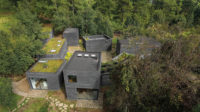Mar Azul, Argentina
No hotel tower or gritty boardwalk impedes the dramatic sunset over the wide, windswept beach of Mar Azul, a remote and laid-back vacation town a few hours from Buenos Aires on Argentina's South Atlantic coast. 'Blue Sea' may be something of a misnomer, as the water is brown and turbid, but the rugged landscape is no less lovely for it.
A few blocks from the shore, calmness prevails in the densely wooded terrain that surrounds Casa BB (named after its owners, Karina Blumencwejg, an industrial designer, and her husband, Cristian Bianchini, a furniture-store owner who trained as an architect). Tall, fragrant pines, black poplars, and sprawling acacia act as a shield from the blazing summer heat, shading the sandy, unpaved roads where horses and ATVs are more common than cars. The vegetation, introduced to the dunes when the town was founded in the 1940s, also protects against the polar winds that whip the beach when the sun goes down. With a resemblance to a rustic campground, Mar Azul is a refuge for artists seeking an escape from city life and contrasts sharply with some of the trendier nearby beach communities.
Even in a town so low-key and peaceful, the simple, exposed-concrete-and-wood Casa BB stands out for its graceful subtlety. Unlike neighboring Alpine-style chalets or retro structures with faux-rock walls and bright-colored paint, the house, with its clean, Modernist lines, submits almost solemnly to the natural environment.
'I wanted the house to take up the least amount of space possible,' says Blumencwejg, who hired Buenos Aires'based BAK Arquitectos after spending several summers with her daughters in two nearby rental properties designed by the firm. 'Nothing here is superfluous or random.' Indeed, the 21 houses designed by BAK in the neighborhood'including that of firm principal Mar'a Victoria Beson'as, who in 2004 built the first as a summer retreat for her own family'evoke the understated force of Le Corbusier, as well as the work of Mies van der Rohe and Louis Kahn. 'What interested us was how well austere architecture fits into the landscape,' says Beson'as, 'as a reflection of a less cluttered life that is more harmonious with its surroundings.'
When Blumencwejg first saw her completed house, bare of any furniture, it reminded her of the sculpture of Basque artist Jorge Oteiza. 'It was so beautiful, I almost wanted to leave it empty,' she says. In fact, with the poured-in-place-concrete kitchen counter and dining-room table, there was little to add: glazing for the windows, shelving, a brick wall to hold bathroom plumbing, and spare furnishings. Light and breezes stream through the house's sliding doors at its front, creating an airy serenity.
Blumencwejg was drawn to BAK's use of concrete as well as the architects' simple designs and pragmatic approach. Very few materials withstand Mar Azul's hostile climate: the unforgiving winds, salty air, and temperature swings from 23 to 100 degrees Fahrenheit. And as a beach getaway that is occupied only four months a year but is constantly trafficked by sandy feet during that time, the house had to be low-maintenance.
For BAK's Luciano Kruk, who oversaw the construction (and who now has his own firm), a limited material palette also made sense in this relatively remote location. To ensure a high level of quality, the architects hired a local carpenter with proficiency in building wood-plank formwork and Kruk trained a five-person team on the artisanal process of pouring the mix into the mold. But the architect was also enthralled with the aesthetic qualities of concrete. 'The beauty has to do with contrast. We sought an equilibrium between the rustic and the perfect that wouldn't diminish the expressive potential of the material,' he says.
The architects took advantage of the sloping site to comply with Blumencwejg's request to set the master bedroom apart from the rest of the L-shaped house. That room and an adjacent bathroom and terrace were constructed at the foot of the incline, so they float over the forest floor, while the windows at the back of the house'in the living room, kitchen, and one of the two nearly identical guest rooms'are almost level with the ground, creating the sensation of being in a tent.
Casa BB's clean horizontal lines playfully interact with the verticality of the woods, creating a dialogue between the natural and the man-made. At times these worlds literally converge, as when pine trees pass through holes cut in the deck. Although concrete evokes a certain roughness, the formwork's wood-grain impression expressed on the surfaces softens the rationalist design, and the muted monochrome of the walls delicately offsets the brown, green, and beige of the surrounding forest.
Emily Schmall, who writes for the New York Times, is based in Buenos Aires.
Completion Date: March 2010
Size: 1,075 square feet
Total construction cost: $100,000
Architect:
BAK Arquitectos
Ntra. Sra. del Buen Viaje 1011
Morón, Prov. de Buenos Aires, Argentina
Phone +54 11 4489-5424
info@besoniasalmeida.com
PeopleOwner: Karina Blumencwejg
Architect Associate Architect: Nuria Jover
Personnel in architect's firm who should receive special credit:
Photographer(s):
Renderer(s): |
ProductsConcrete: Pasalto Aluminum and Glass: Aberturas Vidal Plumbing fixtures: Deca Piazza Faucets: FV |








